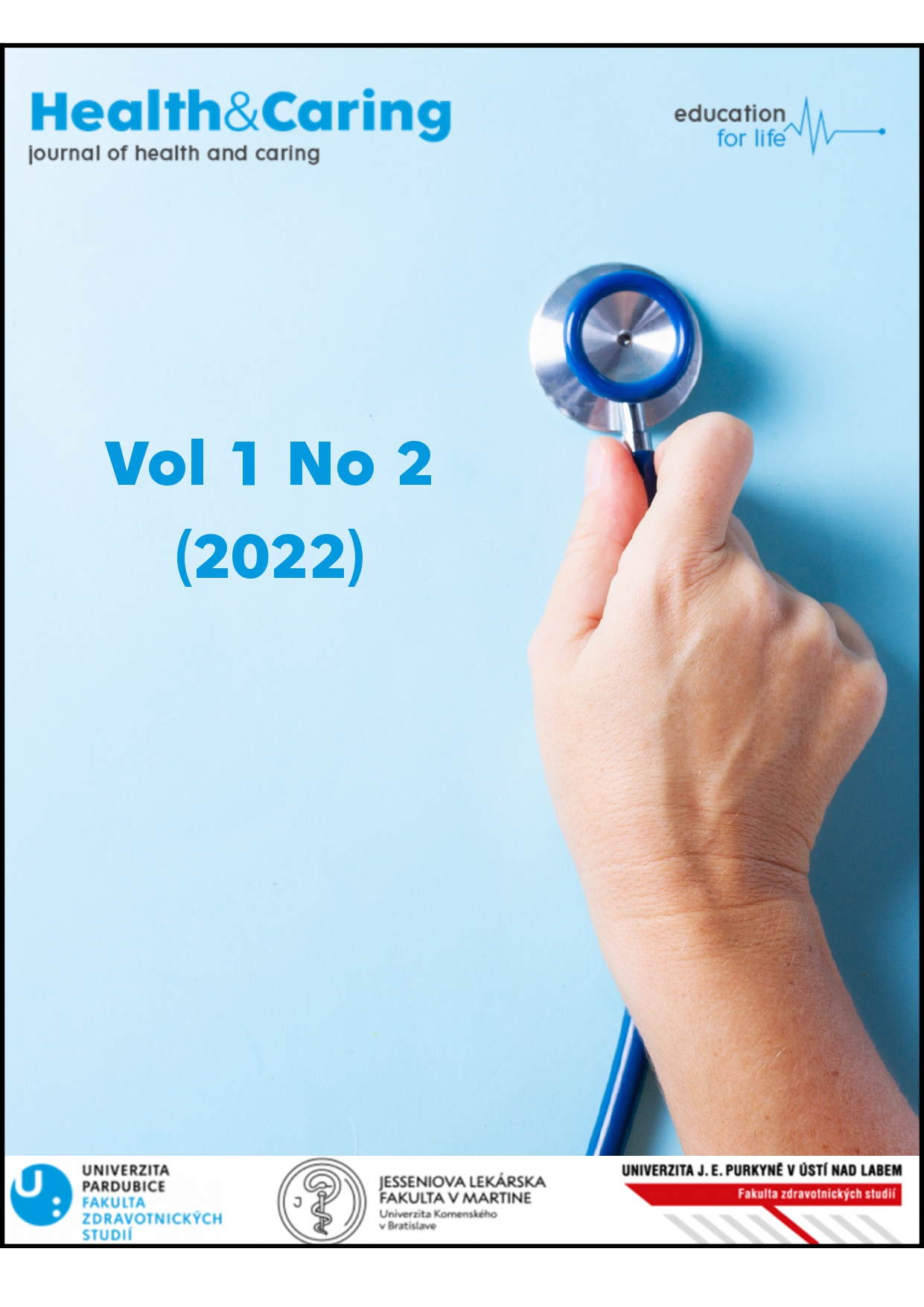INVESTIGATING THE PREVALENCE, PATTERNS AND PREDICTORS OF RATIONED NURSING CARE AT INTENSIVE CARE UNITS
DOI:
https://doi.org/10.46585/hc.2022.2.2101Keywords:
rationed care; nursing; nurses; intensive careAbstract
Background: Rationed nursing care is a significant and widespread problem jeopardizing patient safety and quality of nursing care, mainly in an outpatient setting.
Objective: To explore the prevalence, patterns and predictors of rationed nursing care among nurses working in intensive care units in Slovakia.
Method: The study has adopted a cross-sectional design. Data were collected using the Perceived Implicit Rationing of Nursing Care instrument (PIRNCA). The respondents were intensive care nurses (N=279) from seven hospitals in Slovakia.
Results: The mean level of rationed nursing care was 1.68 (SD = 0.91). The prevalence of rationed nursing care was significantly predicted by nurse education, specialization training, overtime hours, intention to leave the profession, perceived staff adequacy. Quality of patient care and job satisfaction were the most significant predictors of rationed nursing care (p ≤ .05).
Conclusions: Hospital management should immediately address the predictors of rationed nursing care in intensive care units to increase quality and safe care, thus improving patient outcomes. Further examination of the quality of patient care and job satisfaction of nurses and their associations with rationed nursing care is needed in intensive care units.
Downloads
References
Al-Kandari, F., & Thomas, D. (2009). Factors contributing to nursing task incompletion as perceived by nurses working in Kuwait general hospitals. Journal of clinical nursing, 18(24), 3430–3440. https://doi.org/10.1111/j.1365-2702.2009.02795.x
Eskin Bacaksiz, F., Alan, H., Taskiran Eskici, G., & Gumus, E. (2020). A cross-sectional study of the determinants of missed nursing care in the private sector: Hospital/unit/staff characteristics, professional quality of life and work alienation. Journal of nursing management, 28(8), 1975–1985. https://doi.org/10.1111/jonm.12999
Bagnasco, A., Dasso, N., Rossi, S., Timmins, F., Aleo, G., Catania, G., Zanini, M., & Sasso, L. (2020). A qualitative descriptive inquiry of the influences on nurses' missed care decision-making processes in acute hospital paediatric care. Journal of nursing management, 28(8), 1929–1939. https://doi.org/10.1111/jonm.12935
Bragadóttir, H., Kalisch, B. J., & Tryggvadóttir, G. B. (2017). Correlates and predictors of missed nursing care in hospitals. Journal of clinical nursing, 26(11–12), 1524–1534. https://doi.org/10.1111/jocn.13449
Bragadóttir, H., & Kalisch, B. J. (2018). Comparison of reports of missed nursing care: Registered Nurses vs. practical nurses in hospitals. Scandinavian journal of caring sciences, 32(3), 1227–1236. https://doi.org/10.1111/scs.12570
Campbell, C. M., Prapanjaroensin, A., Anusiewicz, C. V., Baernholdt, M., Jones, T., & Patrician, P. A. (2020). Variables associated with missed nursing care in Alabama: A cross-sectional analysis. Journal of nursing management, 28(8), 2174–2184. https://doi.org/10.1111/jonm.12979
Chaboyer, W., Harbeck, E., Lee, B. O., & Grealish, L. (2021). Missed nursing care: An overview of reviews. The Kaohsiung journal of medical sciences, 37(2), 82–91. https://doi.org/10.1002/kjm2.12308
Chapman, R., Rahman, A., Courtney, M., & Chalmers, C. (2017). Impact of teamwork on missed care in four Australian hospitals. Journal of clinical nursing, 26(1–2), 170–181. https://doi.org/10.1111/jocn.13433
Cho, E., Lee, N. J., Kim, E. Y., Kim, S., Lee, K., Park, K. O., & Sung, Y. H. (2016). Nurse staffing level and overtime associated with patient safety, quality of care, and care left undone in hospitals: A cross-sectional study. International journal of nursing studies, 60, 263–271. https://doi.org/10.1016
Dhaini, S. R., Zúñiga, F., Ausserhofer, D., Simon, M., Kunz, R., De Geest, S., & Schwendimann, R. (2017). Are nursing home care workers' health and presenteeism associated with implicit rationing of care? A cross-sectional multi-site study. Geriatric nursing (New York, N.Y.), 38(1), 33–38. https://doi.org/10.1016/j.gerinurse.2016.07.003
Gurková, E., Mikšová, Z., & Šáteková, L. (2021). Missed nursing care in hospital environments during the COVID-19 pandemic. International nursing review, 10.1111/inr.12710. Advance online publication. https://doi.org/10.1111/inr.12710
Gurková, E., Adamkovič, M., Jones, T., Kurucová, R., Kalánková, D., & Žiaková, K. (2020). Factor analysis, validity of the perceived implicit rationing of nursing care instrument and prevalence and patterns of unfinished nursing care in Slovakia. Journal of nursing management, 28(8), 2036–2047. https://doi.org/10.1111/jonm.12887
Gustafsson, N., Leino-Kilpi, H., Prga, I., Suhonen, R., Stolt, M., & RANCARE consortium COST Action – CA15208 (2020). Missed Care from the Patient's Perspective – A Scoping Review. Patient preference and adherence, 14, 383–400. https://doi.org/10.2147/PPA.S238024
Harvey, C., Baldwin, A., Thompson, S., Willis, E., Meyer, A., Pearson, M., & Otis, E. (2020). Balancing the scales-Nurses' attempts at meeting family and employer needs in a work-intensified environment. Journal of nursing management, 28(8), 1873–1880. https://doi.org/10.1111/jonm.12913
Higgs, M., Fernandez, R., Polis, S., & Manning, V. (2020). Similarities and Differences in Nurse-Reported Care Rationing Between Critical Care, Surgical, and Medical Specialties. Journal of patient safety, 16(3), e162–e168. https://doi.org/10.1097/PTS.0000000000000295
Jones T. L. (2014). Validation of the Perceived Implicit Rationing of Nursing Care (PIRNCA) instrument. Nursing forum, 49(2), 77–87. https://doi.org/10.1111/nuf.12076
Jones, T. L., Gemeinhardt, G., Thompson, J. A., & Hamilton, P. (2016). Measuring Unfinished Nursing Care: What to Consider When Choosing and Scoring Surveys. Journal of nursing care quality, 31(1), 90–97. https://doi.org/10.1097/NCQ.0000000000000143
Jones, T. L., Hamilton, P., & Murry, N. (2015). Unfinished nursing care, missed care, and implicitly rationed care: State of the science review. International journal of nursing studies, 52(6), 1121–1137. https://doi.org/10.1016/j.ijnurstu.2015.02.012
Kalánková, D., Kirwan, M., Bartoníčková, D., Cubelo, F., Žiaková, K., & Kurucová, R. (2020). Missed, rationed or unfinished nursing care: A scoping review of patient outcomes. Journal of nursing management, 28(8), 1783–1797. https://doi.org/10.1111/jonm.12978
Kalánková, D., Suhonen, R., Stolt, M., Kurucová, R., Katajisto, J., Žiaková, K., & Gurková, E. (2020). Psychometric testing of perceived implicit rationing of nursing care (PIRNCA). Journal of advanced nursing, 76(6), 1469–1482. https://doi.org/10.1111/jan.14351
Kalisch, B. J., Doumit, M., Lee, K. H., & Zein, J. E. (2013). Missed nursing care, level of staffing, and job satisfaction: Lebanon versus the United States. The Journal of nursing administration, 43(5), 274–279. https://doi.org/10.1097/NNA.0b013e31828eebaa
Kalisch, B. J., & Lee, K. H. (2010). The impact of teamwork on missed nursing care. Nursing outlook, 58(5), 233–241. https://doi.org/10.1016/j.outlook.2010.06.004
Kalisch, B. J., & Williams, R. A. (2009). Development and psychometric testing of a tool to measure missed nursing care. The Journal of nursing administration, 39(5), 211–219. https://doi.org/10.1097/NNA.0b013e3181a23cf5
Kiekkas, P., Tsekoura, V., Fligou, F., Tzenalis, A., Michalopoulos, E., & Voyagis, G. (2021). Missed Nursing Care in the Postanesthesia Care Unit: A Cross-Sectional Study. Journal of perianesthesia nursing: official journal of the American Society of PeriAnesthesia Nurses, 36(3), 232–237. https://doi.org/10.1016/j.jopan.2020.10.009
Liu, X., Zheng, J., Liu, K., Baggs, J. G., Liu, J., Wu, Y., & You, L. (2018). Hospital nursing organizational factors, nursing care left undone, and nurse burnout as predictors of patient safety: A structural equation modeling analysis. International journal of nursing studies, 86, 82–89. https://doi.org/10.1016/j.ijnurstu.2018.05.005
Megyesiová, S. (2021). Nurses and midwives in Slovakia – important trends and ageing of the nursing workforce. Kontakt, 10.32725/kont.2021.043. Advance online publication. https://doi.org/10.32725/kont.2021.043
Młynarska, A., Krawuczka, A., Kolarczyk, E., & Uchmanowicz, I. (2020). Rationing of Nursing Care in Intensive Care Units. International journal of environmental research and public health, 17(19), 6944. https://doi.org/10.3390/ijerph17196944
OECD (2019), Health at a Glance 2019: OECD Indicators, OECD Publishing, Paris,
https://doi.org/10.1787/4dd50c09-en
Ogboenyiya, A. A., Tubbs-Cooley, H. L., Miller, E., Johnson, K., & Bakas, T. (2020). Missed Nursing Care in Pediatric and Neonatal Care Settings: An Integrative Review. MCN. The American journal of maternal child nursing, 45(5), 254–264. https://doi.org/10.1097/NMC.0000000000000642
Palese, A., Ambrosi, E., Prosperi, L., Guarnier, A., Barelli, P., Zambiasi, P., Allegrini, E., Bazoli, L., Casson, P., Marin, M., Padovan, M., Picogna, M., Taddia, P., Salmaso, D., Chiari, P., Marognolli, O., Canzan, F., Gonella, S., & Saiani, L. (2015). Missed nursing care and predicting factors in the Italian medical care setting. Internal and emergency medicine, 10(6), 693–702. https://doi.org/10.1007/s11739-015-1232-6
Recio-Saucedo, A., Dall'Ora, C., Maruotti, A., Ball, J., Briggs, J., Meredith, P., Redfern, O. C., Kovacs, C., Prytherch, D., Smith, G. B., & Griffiths, P. (2018). What impact does nursing care left undone have on patient outcomes? Review of the literature. Journal of clinical nursing, 27(11–12), 2248–2259. https://doi.org/10.1111/jocn.14058
Rooddehghan, Z., Yekta, Z. P., & Nasrabadi, A. N. (2018). Ethics of rationing of nursing care. Nursing ethics, 25(5), 591–600. https://doi.org/10.1177/0969733016664973
Rozensztrauch, A., Uchmanowicz, I., Suchowska, B., & Śmigiel, R. (2021). Translation and psychometric testing of the Polish version of the Neonatal Extent of Work Rationing Instrument (NEWRI). Annals of agricultural and environmental medicine: AAEM, 28(1), 94–98. https://doi.org/10.26444/aaem/116907
Schubert, M., Ausserhofer, D., Desmedt, M., Schwendimann, R., Lesaffre, E., Li, B., & De Geest, S. (2013). Levels and correlates of implicit rationing of nursing care in Swiss acute care hospitals a cross sectional study. International journal of nursing studies, 50(2), 230–239. https://doi.org/10.1016/j.ijnurstu.2012.09.016
Schubert, M., Clarke, S. P., Glass, T. R., Schaffert-Witvliet, B., & De Geest, S. (2009). Identifying thresholds for relationships between impacts of rationing of nursing care and nurse and patient-reported outcomes in Swiss hospitals: a correlational study. International journal of nursing studies, 46(7), 884–893. https://doi.org/10.1016/j.ijnurstu.2008.10.008
Schubert, M., Glass, T. R., Clarke, S. P., Schaffert-Witvliet, B., & De Geest, S. (2007). Validation of the Basel Extent of Rationing of Nursing Care instrument. Nursing research, 56(6), 416–424. https://doi.org/10.1097/01.NNR.0000299853.52429.62
Schubert, M., Glass, T. R., Clarke, S. P., Aiken, L. H., Schaffert-Witvliet, B., Sloane, D. M., & De Geest, S. (2008). Rationing of nursing care and its relationship to patient outcomes: the Swiss extension of the International Hospital Outcomes Study. International journal for quality in health care: journal of the International Society for Quality in Health Care, 20(4), 227–237. https://doi.org/10.1093/intqhc/mzn017
Suhonen, R., Stolt, M., Habermann, M., Hjaltadottir, I., Vryonides, S., Tonnessen, S., Halvorsen, K., Harvey, C., Toffoli, L., Scott, P. A., & RANCARE Consortium COST Action – CA 15208 (2018). Ethical elements in priority setting in nursing care: A scoping review. International journal of nursing studies, 88, 25–42. https://doi.org/10.1016/j.ijnurstu.2018.08.006
Szalay A (2016). Spracovanie analýzy o dĺžke pracovného času, nadčasov a nepretržitej prevádzky. Slovenský odborový zväz zdravotníctva a sociálnych služieb, Bratislava, https://sozzass.com/(in Slovak). Accessed November 03, 2021.
Tubbs-Cooley, H. L., Pickler, R. H., Younger, J. B., & Mark, B. A. (2015). A descriptive study of nurse-reported missed care in neonatal intensive care units. Journal of advanced nursing, 71(4), 813–824. https://doi.org/10.1111/jan.12578
Uchmanowicz, I., Kołtuniuk, A., Młynarska, A., Łagoda, K., Witczak, I., Rosińczuk, J., & Jones, T. (2020). Polish adaptation and validation of the Perceived Implicit Rationing of Nursing Care (PIRNCA) questionnaire: a cross-sectional validation study. BMJ open, 10(4), e031994. https://doi.org/10.1136/bmjopen-2019-031994
VanFosson, C. A., Jones, T. L., & Yoder, L. H. (2018). Monthly variation of unfinished nursing care at the US Army Burn Center. Burns: journal of the International Society for Burn Injuries, 44(8), 1910–1919. https://doi.org/10.1016/j.burns.2018.03.008
Zeleníková, R., Gurková, E., Friganovic, A., Uchmanowicz, I., Jarošová, D., Žiaková, K., Plevová, I., & Papastavrou, E. (2020). Unfinished nursing care in four central European countries. Journal of nursing management, 28(8), 1888–1900. https://doi.org/10.1111/jonm.12896
Zúñiga, F., Ausserhofer, D., Hamers, J. P., Engberg, S., Simon, M., & Schwendimann, R. (2015). The relationship of staffing and work environment with implicit rationing of nursing care in Swiss nursing homes – A cross-sectional study. International journal of nursing studies, 52(9), 1463–1474. https://doi.org/10.1016/j.ijnurstu.2015.05.005
Downloads
Published
How to Cite
Issue
Section
License
Copyright (c) 2022 Dominika Kalánková, Daniela Bartoníčková, Katarína Žiaková

This work is licensed under a Creative Commons Attribution-NonCommercial 4.0 International License.
Accepted 2022-08-31
Published 2022-09-30










